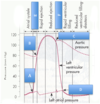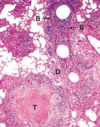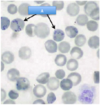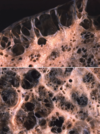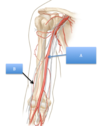Spotter Flashcards
What does this ECG show and why?

S-T depression, can be sign of chronic ischaemia
Label A-C

A: arcuate vessels
B: interlobular arteries
C: interlobar vessels
What are A, B and C?

A: posterior intercostal artery
B: lateral cutaneous branch
C: anterior intercostal artery
Label A-F around the diaphragm.

A: Aorta
B: R sympathetic trunk
C: L sympathetic trunk
D: Azygos
E: Thoracic duct
F: IVC
NB: diaphragm attachement around costal margin (inferior border of lower rib)
What changes can you see in this asthma-affected airway?

Mucous plugging
Wall thickening (inflammation)
Smooth muscle hypertrophy
What is wrong in this Xray?

Mitral valve stenosis, enlarged L atrium and pulmonary oedema.

What are the 2 main features of this CXR?

Batwing
Blunting of costophrenic angle. If fluid in pleural cavity, goes to this area due to gravity = indicitave of pleural effusion, can be caused by many things e.g. heart failure
Label A-C (with percentages)

A: plasma 55% (water 90%, solutes 10%)
B: erythrocytes (45%)
C: Leukocytes and thrombocytes (platelets)
What is this showing in the lungs and why?

Pulmonary TB
Early Mycobacterium tuberculosus - early caseous granuloma , central area of caseous necrosis (CN), surrounded by macrophages (M) which fuse to giant Langerhans cells (L). Arrows = rim of lymphocytes.
What type of ciliated epithelium is this?
What is the arrow pointing to?
What are the arrow heads pointing to?

Simple columnar
Smooth muscle
BALT
65yo male, increasing breathlessness on exertion, long history of diabetes mellitus and hypertension leading to poor renal function. Low Hb.
How would you best classify this patient’s anaemia?
What terms describe the red cell appearances?
What is the most likely reason for this patient’t anaemia?

Normocytic
Acanthocytes (burr cells), schistocytes (fragments), anisocytosis (diff shapes), poikilocytosis (diff sizes)
Erythropoietin deficiency. (Anaemia due to chronic renal failure and consequent EPO deficiency, anaemia usually normocytic with red cells showing abnormalities including spicules and “burr” cells. Red cell fragments may be seen with renal vascular disease).
What does this ECG show and why?

No P wave - atrial fibrillation (pacemaker cells firing at different times = asynchronised and no electrical activity)
What is B in the lung?

Bronchiole
What are the features on this CXR?

Pleural effusion (in e.g heart failure, lungs so saturated that fluid accumulates in pleural space. A step worse from pulm oedema.
Pulmonary oedema (fluid in intersitium)
Large cardiothoracic ratio
Chest wires
What can you see in this CXR and what does this suggest?

Visceral pleural edge, air in pleural cavity
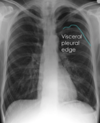
Pneumothorax
Label A-D

A: pituitary stalk
B: hypothalamus
C: pituitary gland
D: hypothalamus
Label the parts of the sternum

A: Sternal angle
B: xiphoid process
C: manubrium
4: body
What are these structures?

Seromucous glands
What are A-F?

A: coronary sinus
B: fossa ovalis
C: tricuspid valve
D: chordae tendinae
E: papillary muscles
F: trabeculae carnae
This is a longitudinal section of foetal trachea branching into the main bronchi. What is the tissue indicated by the arrows?

Hyaline cartilage
What do these CXRs show?

Pneumothorax - in 1) clearly see L lung pulled away from side, in 2) can see R visceral pleural edge
What does this CXR show? (Normal on L)

Hyperinflation - dyspnea
Identify the 3 lung cell carcinomas.

A: small cell carcinoma (small, ovoid and densely packed, dark stained, disseminate widely)
B: squamous cell carcinoma (large esinophill cells/central whorling)
C: Adenocarcinoma (G = gland)
What are A and B?

A: azygos vein
B: hemiazygos vein
What condition is this? Explain the colour.
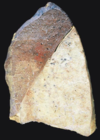
Lobar consolidation.
Lower lobe shows lobar consolidation.
What has happened in this Xray?
List possible causes.

Pulled airways.
collapse of lobe, loss of lung volume, consolidation, fibrosis

Label the major and accessory muscles involved in inspiration, A-F

A: SCM
B: Pectoralis major
C: Rectus abdominis
D: Pec minor
E: Serratus anterior
F: External intercostal muscles
Comment on this ECG. What could have caused it?

AMI = STE: II, III, aVF. Blocked RCA.
Label A and B

A: basilic vein
B: cephalic vein
NB: deep veins take same name as arteries.
If body is A, remember it as A -> B -> C in anatomical position
Label A-F

A: Frontal sinus
B: ethmoid air cells
C: sphenoid air sinus /opening of
D: maxillary air sinus (opening of)
E: frontonasal duct
F: semi lunar hiatus
Label 1-6 of the femoral triangle.

- femoral artery
- femoral nerve
- femoral vein
- ASIS and lateral femoral cutaneous nerve
- inguinal ligament
- sartorius
Label A-D

A: superficial palmar arch
B: metacarpal artery
C: digital artery
D: deep palmar arch
NB. metacarpal and digital arteries arise from arches and supply fingers
Palmar arches: anastamoses of R and V arteries
What can you see in this CXR?
What is this caused in congestive heart failure?
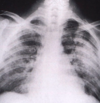
Pulmonary oedema. Bat wings (bilateral perihilar shadowin due to fluid accumulation)
Heart unable to pump blood efficiently, blood can back up into veins that take blood through lungs. As pressure in these BV increases. fluid is pushed into alveoli in lungs, reducing normal O2 movement.
Identify A and B in the brochus

A: seromucus glands
B: hyaline cartilage
Describe the cell and possible diagnosis.

Hypersegmented neutraphils. Macrocytic anaemia - B12/folate deficiency
Label A-C

A: tunica intima
B: tunica media
C: tunica adventitia
Label A-D

A: pulmonary valve
B: aortic valve
C: mitral valve
D: tricuspid valve
Label A-E in blood cell development

A: myeloid SC
B: myeloblast
C: lymphoid SC
D: megakariocyte
E: lymphoblast
Label A-D

A: R. subclavian
B: brachiocephalic trunk
C: R and L common carotids
D: L. subclavian
What are A-F?

A: SVC
B: fossa ovalis
C: IVC
D: coronary sinus
E: tricuspid valve
F: pectinate muscle
What stage of these images is pulmonary TB? What can be seen?

Later TB. Fibroblasts lay down collagen in ECM to wall off tubercle.
A patient has had a troublesome cough for a year, brings up whitish sputum. What has happened to the mucus producing cells here? What condition causes this?

Hypertrophied.
Chronic bronchitis
Label A-D in the bronchus

A: pseudostratified columnar epithelium
B: lamina propria
C: muscularis mucosae
D: submucosa
Label A-C. What is happening?

A: endothelium B: hemorrhage C: plaque
Unstable plaque (still covered by endothelium)
Photomicrograph from conducting airway. What kinds of cells are A and B?

A: stratified squamous epithelium
B: pseudostratified columnar epithelium with goblet cells
(NB. B have become A due to metaplasia from smoking)
Label A-D
What is C sensory and motor to?
What are the contents of the carotid sheath?

A: Brachial plexus
B: Vagus nerve
C: Phrenic nerve
D: L recurrant laryngeal nerve
Sensory to the two membranes it’s inbetween: the mediastinal section of parietal pleura and pericardium. Motor to diaphragm.
IJV, carotid arteries, vagus (IC 10 CCs in the IV)
NB: phrenic starts more laterally and decreases to diaphragm. More anterior. Vagus starts in carotid sheath more posterior and continues to move posteriorly on L side next to oesophagus -> through osophageal hiatus (T10)
What is does this CT show?

Sinusitis - mucus accumulation. May have toothache and frontal facial pain.
Label A and B

A: internal thoracic artery
B: R. subclavian artery
Label A-D
What is this structure?
A: intermediate filament
B: dense body
C: mechanical junction coupling cells
D: gap junction for electrical and chemical communication
Smooth muscle
What is this image showing?

Aortic stenosis - calcifications on stenotic valve

Label A-F

A: horizontal fissure
B and C: oblique fissure
D: lobar bronchus
E: segmental bronchi
F: carina (sternal angle)
Determine whether A and B are PA or AP Xrays and why.

A: PA
B: AP because scapula lies over lung fields and clavicles are horizontal
Label A-C of this platelet.

A: lipid bilayer cell membrane, and glycoprotein receptors
B: dense body
C: alpha granule
17yo female, sore eyes, nasal discharge, eosinaphils raised.
What is the salient feature of the blood count and film?
What is the likely diagnosis?

Eosinophilia
Allergic rhinitis
What are A & B?

A: Internal intercostal muscle
B: External intercostal muscle
Label A-D in a conducting airway.

A: columnar cells
B: cilia
C: goblet cell
D: mucus
NB. in lower condicting airways (bronchioles), simple epithelium only. Epithelium EXCEPT ALVEOLAR is covered with mucus
Label Waldeyer’s ring, A-D.

A: adenoid
B: tubal tonsil
C: palatine tonsil
D: lingual tonsil
3yo male, vegetarian meal, became unwell, pink urine, favism diagnosis. Low Hb, high reticulocytes, heinz bodies seen on reticulocyte preparation (oxidised denatured Hb).
What are the salient features of his blood film (above)?
How would you best classify his anaemia?
What are the key factors leading to the development of this patient’s anaemia?

Polychromasia (high number of immature RBC), basket cells (bite/blister cells)
Non-spherocytic haemolytic anaemia
Glucose-6-phosphate dehydrogenase (G6PD) deficiency and ingestion of fava beans. (Most sig in Mediterraneans, sex-linked male inheritance, female carriers show half the normal G6PD cell value.
G6PD reduces NADP while oxidising glucose-6-phosphate. It’s the only source of NADPH in red cells and deficiency renders cell susceptible to oxidant stress. Deficiency usually asymptomatic, but in response to oxidant stress e.g. drugs, fava beans, or infections, acute haemolytic anaemia develops. Heinz bodies are formed in red cells in response to oxidant stress and are removed by the spleen, leading to acute intravascular haemolysis with haemoglobinuria. Heinz body removal leaves ‘basket’ or ‘bite’ red cells.)
Label the facia of the neck, A-D
What structures does B contain?

A: pretracheal fascia
B: carotid sheath
C: Prevertebral fascia
D: deep investing fascia
E: retropharyngeal space (between PTF and PVF)
common carotid artery, internal jugular vein, vagus nerve (VIC)
70yo female, increasing tiredness and breathlessness, recently constipated, pale.
What are the salient red cell features in this blood film?
How would you best classify the pt’s anaemia?
What is the most likely cause?
What is the likely diagnosis?

Pencil cells
Microcytosis
Hyperchromasia
Microcytic
Fe deficiency
Large bowel carcinoma
Label A-C in the alveoli

A: Type 1 pneumatocyte
B: Type 2 pneumatocyte
C: Alveolar macrophage (b/c mucus would compromise gas exchange, so no mucus but macrophages instead)
What is this muscle?

Cardiac
What type of cells are P1, P2 and M?

P1: type 1 pneumatocytes
P2: type 2 pneumatocytes
M: macrophage
Label D, 6, 7, 9 and 11

D: juxtaglomerular apparatus
6: granualar cells (juxtaglomerular cells)
7. macula densa
9. afferent arteriole
11: efferent arteriole
Label A-E

A: superior cervical sympathetic ganglion
B: Cervical sympathetic trunk
C: Vertebral artery
D: Middle cervical ganglion
E: Inferior cervical ganglion
What does this ECG show and why?

S-T elevation = acute ischaemia (but most common cause = AMI)
Identify the components of the adult trachea shown.

- epithelium
- seromucus glands
- lamina propria/submucosa
- hyaline cartilage
- adventita
Label A-D

A: tricuspid valve
B: mitral valve
C: aortic valve
D: pulmonary valve
Label A-C of the larynx during rest

A: vestibular fold - choking reflex
B: Rima glottidis - aperture
C: vocal fold - contain vocal ligament and vocalis muscle
Label A-C and explain the function of A and B

A: metarteriole
B: throughfare channel
C: precapillary sphincter
A and B = vascular shunt, arteriovenous anastomoses, flow through capillary bed can be shut off and blood goes directly through from arteriole -> venule
64yo male, 3 day history of fever, sweating, vomiting and rigors, recently returned from trip to uganda. Platelets and Hb low.
What diagnostic feature is present on the blood film?

Malarial parasites in red cells. (Some degree of haemolysis seen in all types of malaria. Thrombocytopenia is commonly found in acute malaria. Reticulocytosis is usually present in the face of haemolysis but this is often absent in the face of overwhelmind sepsis.)
What has happened in this Xray?
List possible causes.

Pushed airway
Masses, tension pneumothorax

What are A,B and C?

A: jugular notch
B: costal cartilages
C: costal margin
What does this Xray show and what could have caused it?

Blunted costophrenic angle (L and R)
Can be caused by fluid in pleural cavity - pleural effusion
Label A-D

A: L recurrant laryngeal
B: Vagus
C: phrenic
D: azygos vein
The nerves are anterior to the lung root.
19yo med student, sore throat, friend recently had glandular fever, temp 39 degrees and tonsils inflammed with pustular exudate. HIgh neutrophil levels (neutrophilia).
What is the likely cause of this pt’s sore throat?

Bacterial infection (glandular fever is caused by Epstein Barr virus so would cause other alterations in blood results)
Label A and B. What is does A do?

A: catrotid body B: carotid sinus
Label A-C. ECG leads vaguely correspond to areas of the myocardium supplied by the coronary arteries. Label which ones.

A: LCx or diagonal branch of LAD
B: RCA or LCx
C: LAD

























